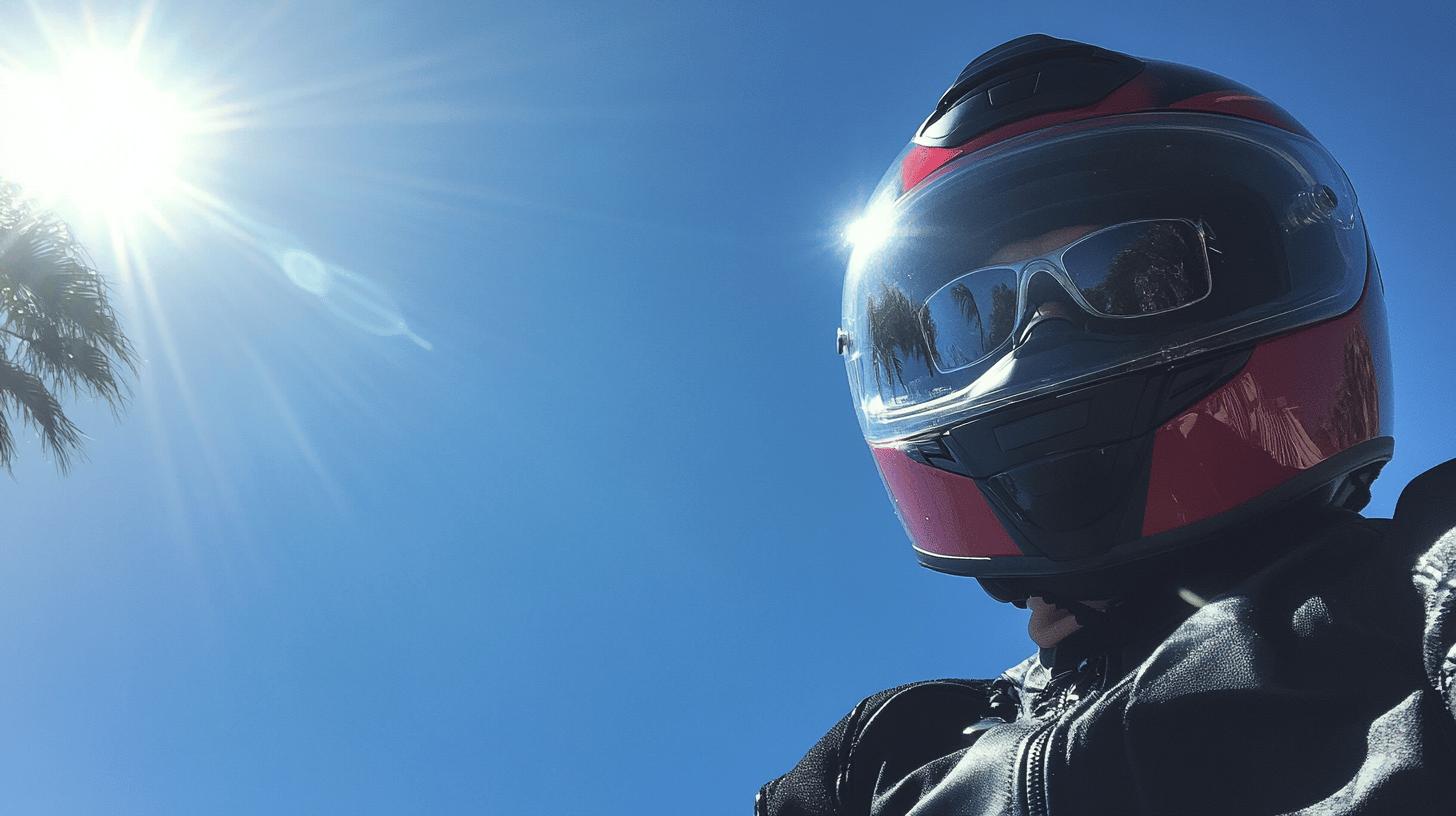Ever felt like you're riding with a furnace strapped to your head? Keeping cool while wearing a motorcycle helmet can seem challenging, but it’s crucial for comfort and focus on the road.
Choosing a helmet with optimal ventilation can make all the difference. Equipped with advanced cooling technologies, the right helmet can transform a potentially sweltering ride into a breeze.
This guide will explore how selecting helmets with superior airflow can enhance your riding experience, offering recommendations on top-performing models like the HJC i10, AGV K3 SV, and Shoei RF1400, renowned for their ventilation prowess.
Choosing Helmets with Optimal Ventilation for Cool Rides

Ventilation is a critical factor in keeping a rider's head cool while wearing a motorcycle helmet. Without efficient airflow, heat and humidity can build up inside the helmet, leading to discomfort and decreased focus. Helmets designed with advanced ventilation systems can significantly enhance riding comfort by allowing fresh air to circulate while expelling hot air.
Key ventilation features to look for in helmets include:
-
Multiple intake vents: These allow air to enter the helmet, providing cooling relief.
-
Exhaust vents: Positioned to let hot air escape, these are essential for maintaining airflow.
-
Adjustable venting systems: Offer the flexibility to manage airflow based on riding conditions.
-
Channeled EPS liners: Enhance internal airflow and help distribute cool air evenly.
-
Moisture-wicking interiors: Help manage sweat, keeping the rider dry and comfortable.
Different helmet styles address cooling needs in various ways. Full-face helmets, such as the Shoei RF1400, often include comprehensive ventilation systems with strategically placed vents to maximize airflow across the entire head.
Modular helmets, like the AGV K3 SV, offer the added advantage of a liftable chin bar, increasing airflow when needed while maintaining the protection of a full-face design. Open-face helmets provide the least restriction to airflow, making them a popular choice in hot climates, although they offer less protection.
For riders seeking helmets with superior ventilation, models like the HJC i10, AGV K3 SV, and Shoei RF1400 stand out due to their advanced cooling technologies. The HJC i10, for instance, integrates a multi-vent system that optimizes airflow without compromising safety.
These helmets demonstrate that you don't need to sacrifice comfort for protection, as they feature innovative designs to keep riders cool even during long rides under the sun.
Using Cooling Accessories for Maximum Comfort

Incorporating cooling accessories within a motorcycle helmet can significantly enhance comfort by managing heat and moisture. These accessories are designed to reduce sweat buildup and improve airflow, making long rides in hot weather more bearable. By utilizing these innovations, riders can maintain a cooler head and stay focused on the road.
Recommended cooling accessories include:
-
Cooling helmet inserts: Help lower the interior temperature by absorbing and dissipating heat.
-
Moisture-wicking helmet liners: Draw sweat away from the skin, keeping the rider dry.
-
Balaclavas: Provide an additional layer that absorbs sweat and enhances comfort.
- Removable, washable interiors: Allow for easy cleaning, reducing odors and maintaining freshness.
Using these accessories effectively involves selecting items that fit well within the helmet and complement its ventilation system. Cooling inserts, for example, can be placed strategically to maximize their impact, while moisture-wicking liners should cover the major contact points with the skin.
Balaclavas, made from breathable materials, can offer added protection against sweat while ensuring comfort. Regularly washing removable liners and other accessories is essential for hygiene and preventing odor buildup, thus ensuring a fresh riding experience each time.
Hydration's Role in Keeping Your Head Cool

Hydration is crucial for regulating body temperature and ensuring rider comfort, especially in hot weather. When the body is properly hydrated, it can effectively manage internal heat, preventing overheating.
Sweating is a natural cooling mechanism, and adequate fluid intake is necessary to maintain this process. Without sufficient hydration, the body's ability to cool itself diminishes, leading to discomfort and potential heat-related issues while wearing a helmet.
To maintain hydration and, consequently, keep your head cool, practical measures are essential. Riders should carry a water bottle or use a hydration pack, allowing easy access to fluids during stops.
Drinking water regularly, even before feeling thirsty, helps maintain hydration levels. Incorporating electrolyte-rich drinks can also be beneficial, as they replenish essential salts lost through sweat, enhancing overall comfort and cooling efficiency during rides.
Helmet Maintenance for Enhanced Cooling Performance

Regular helmet maintenance is crucial to ensure optimal ventilation and cooling performance. Over time, dust, dirt, and sweat can obstruct the ventilation systems, reducing airflow and making the helmet feel warmer. Cleaning the helmet's vents and liners regularly helps maintain their effectiveness.
Utilizing mild soap and water for the exterior and a soft brush to clear the vents ensures that airflow pathways are not blocked. Keeping these components clean prevents heat buildup, enabling the helmet to perform as designed, providing comfort even during the hottest rides.
To keep the helmet clean and fresh, specific products and practices are recommended. Minty helmet sprays are effective for odor control, providing a refreshing scent while eliminating bacteria that cause unpleasant smells. Washing removable liners in cold water and allowing them to air dry maintains their integrity and comfort.
Avoid using harsh detergents or submerging the entire helmet in water, as this can damage the materials. By following these maintenance tips, riders can enjoy a cooler, more comfortable experience on their summer rides, ensuring the helmet not only protects but also enhances riding enjoyment.
Balancing Safety and Cooling in Helmet Design

Safety features in motorcycle helmets are non-negotiable, even when prioritizing cooling capabilities. What safety features should not be compromised despite the need for cooling? Helmets must incorporate multi-density EPS liners, which are crucial for impact absorption and reducing injury risk during accidents.
This layered foam construction efficiently manages the energy from impacts, ensuring the helmet offers maximum protection. Helmets should also maintain their structural integrity with robust outer shells to withstand external forces.
Retention systems, like secure chin straps, are indispensable for keeping the helmet in place during a crash. These safety elements form the foundation of any helmet, and riders should never sacrifice these core protective features for enhanced airflow or cooling technologies.
How are modern helmet designs integrating cooling technologies without sacrificing safety? Modern helmets are cleverly integrating ventilation systems that work in harmony with safety features. Advanced designs incorporate strategically placed intake and exhaust vents to promote airflow without weakening the helmet's structural integrity.
For instance, helmets from brands like Shoei and AGV utilize aerodynamic shapes that guide air through the helmet, reducing heat buildup while maintaining protective capabilities. Technologies such as channeled EPS liners enhance airflow within the helmet, distributing cool air without compromising on impact absorption.
Furthermore, materials like moisture-wicking liners are incorporated to manage sweat and enhance comfort, reinforcing the helmet's cooling function. By innovating in these areas, helmet manufacturers ensure that riders enjoy a balance of safety and comfort, even in the hottest conditions.
Final Words
Selecting the right motorcycle helmet with optimal ventilation and using cooling accessories are essential for a comfortable ride. Effective ventilation, hydration, and routine helmet maintenance work together to keep your head cool in a motorcycle helmet.
Prioritizing both safety and innovative cooling features ensures you remain protected and comfortable. With these efforts, riders can enjoy a pleasant journey, even on the warmest days.
FAQ
How to keep your head cool in a motorcycle helmet DIY?
Using the SQuAD equation, riders can keep their head cool by ensuring proper helmet ventilation, wearing moisture-wicking liners, and integrating a small battery-operated fan to enhance airflow during rides.
What is the best motorcycle helmet for hot weather?
The best motorcycle helmet for hot weather features superior ventilation. Models like the HJC i10, AGV K3 SV, and Shoei RF1400 are well-regarded for their efficient airflow capabilities, making them ideal choices.
What is a motorcycle helmet fan kit?
A motorcycle helmet fan kit includes small battery-powered fans designed to increase airflow within the helmet to reduce heat and improve comfort during warm riding conditions.
How do motorcycle helmet cooling systems work?
Motorcycle helmet cooling systems improve airflow using intake and exhaust vents, often paired with moisture-wicking liners or integrated fans, to maintain a cooler interior environment for the rider.
What is an air-conditioned helmet?
An air-conditioned helmet utilizes active cooling technology, integrating small air conditioning units to regulate temperature, providing a more comfortable riding experience, especially in hotter climates.
Which motorcycle helmet offers the best airflow?
Helmets like the AGV K3 SV and Shoei RF1400 offer the best airflow, featuring advanced ventilation systems with strategically placed vents for optimal air circulation during rides.
How can I keep my hair nice under a motorcycle helmet?
To maintain hair quality under a motorcycle helmet, use a moisture-wicking liner or bandana to reduce sweat build-up and carry a small comb for adjustment post-ride.
Does it get hot in a motorcycle helmet?
It often gets hot in a motorcycle helmet due to limited ventilation. Choosing helmets with enhanced airflow and using moisture-wicking liners helps in managing heat.
How can I stop my helmet from sweating?
Riders can stop helmet sweating by choosing helmets with proper ventilation, using moisture-wicking liners, and ensuring a snug but comfortable fit to reduce excess perspiration.
How do I keep my head warm with a bike helmet?
To keep the head warm with a bike helmet, riders should wear thermal caps or balaclavas designed for insulation while still maintaining helmet fit and comfort.

Ryan Thompson is a 35-year-old sport bike enthusiast known for his adventurous spirit. With years of weekend rides and exploring new roads, Ryan brings fresh insights and firsthand experience to ProtectiveGearz. His energetic approach and passion for the latest gear make him a trusted source for riders seeking up-to-date advice.



